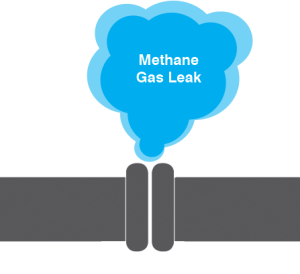 The California Public Utilities Commission (CPUC) recently approved a settlement requiring Pacific Gas and Electric Company (PG&E) to address environmental, as well as safety, factors when fixing natural gas leaks.
The California Public Utilities Commission (CPUC) recently approved a settlement requiring Pacific Gas and Electric Company (PG&E) to address environmental, as well as safety, factors when fixing natural gas leaks.
This comes on the heels of a similar settlement issued by the New York Public Service Commission in December. Together these decisions are ringing in a trend in which the environmental impacts of methane leaking from pipelines are being recognized.
Methane – the main component of natural gas — is responsible for about a quarter of current global warming, and awareness about the magnitude of methane that leaks from local pipelines has been mounting.
Earlier this year CPUC reported that in 2015, California pipelines leaked away 6.6 billion cubic feet of methane. Based on an average wholesale market price of gas, these losses mean ratepayers are paying approximately $18 million every year for gas that is never delivered. That’s more than the amount of gas released by the Aliso Canyon storage facility leak and over twice the amount emitted by all of the state’s oil and gas wells.
Fortunately, advancements in methane detection technology have made finding and fixing gas leaks more affordable than ever. This makes implementation a win-win for safety and integrity, and helps California meet its climate goals.
A mandate for modern tech, more inspections, and increased transparency
The settlement calls for PG&E is to continue to modernize its leak detection capabilities with affordable technologies that can find 80% more leaks in 40% of the time than with previous methods.
These technologies enable companies not only to find leaks, but recent literature suggests they can also estimate leak size. And that makes a big difference when it comes to prioritizing pipeline repair and replacement projects.
Utilities are required by law to fix leaks that pose a safety risk, but non-hazardous leaks – known as grade three leaks — may be allowed to persist often for months of years. In California, utilities including PG&E and Southern California Gas Company have racked up tens of thousands of grade three leaks on the books that they have in recent years begun to repair. These leaks may not pose an immediate safety risk, but they are detrimental to the climate.
That’s why the decision is so important. As part of the settlement, PG&E proposed to expand its use of these technologies across its entire distribution system, and agreed to repair grade three leaks and reduce the backlog of leaks they have already found. PG&E will also increase its leak survey frequency by 20% — from every five years to every four. More frequent surveys of pipeline systems will allow PG&E to find and fix leaks faster. This is particularly impactful when it comes to finding “super emitters” – the random, unpredictable leaks that are responsible for a significant portion of lost gas. Frequent detection is paramount to reducing emissions from these sources since utilities cannot predict where large leaks will occur.
Setting a New Standard
The CPUC decision will increase transparency and take leak data that was once held secret – and give it directly to the public in an easy, accessible way.
Under this new scenario, PG&E agreed to publicly display known leaks in a map form that is accessible through its website – not unlike the maps of gas leaks that EDF and Google pioneered in 2014.

This sets a new standard for transparency with utility companies, showing that it’s possible to provide leak information in a digestible format to the public, without compromising security. The utility is among the leading local distribution companies working to ensure the responsible delivery of natural gas.
Unfortunately, forward-thinking leak detection programs that increase transparency and prioritize the environment aren’t yet the standard across the board.
The CPUC’s decision is part of a general rate case between the Commission and utility. The Commission reviews rate cases every three years to determine if proposed increases are just and reasonable. In this case, the Commission determined that the environmental requirements are reasonable since they are affordable, they improve system integrity, and align with the state’s environmental policies like SB 1383 and SB 1371, which require a reduction of methane emissions and gas leaks.
PG&E is clearly ahead of the pack when it comes to reducing gas leaks, but there’s no reason other utilities shouldn’t be required to modernize their systems in order to protect public health and the environment.
Gas leaks aren’t unique to California. Our mapping data reveal leaks are a persistent problem across the country. Fortunately leak detection technologies are rapidly improving, and if utilities across the country are required to adopt them we could see improved system integrity, increased transparency and more climate protections a lot faster.









